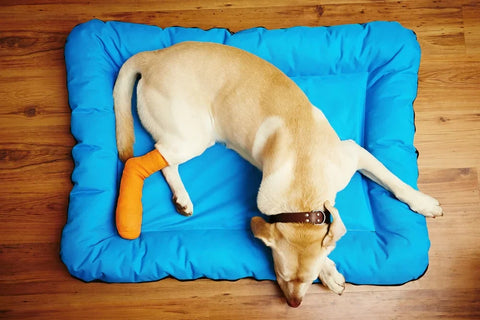

How do I know if my dog is in pain?
It’s heart-wrenching to think of your dog in pain, isn’t it? But our pets can’t tell us when something hurts, so it’s up to us to look for the signs. The good news is, once you know what to look for, you can often tell when your dog might need a little extra care.
Whether it’s changes in behaviour, movement, or appetite, this guide will help you spot dog pain signs. Plus, we’ll explore ways to help your dog get back to their usual happy, ball-chasing self.

Common signs of pain in dogs
Dogs can be great at hiding discomfort, but paying attention to the little changes can make all the difference. Here’s what to look for:
1) Behaviour
Is your dog acting out of sorts? Pain can show up in unusual behaviours like excessive licking (especially of one area), restlessness, or being more withdrawn than usual. Keep an eye out — these subtle changes can be an early sign something’s not quite right.
2) Noise sensitivity
When dogs are in pain, they might become more sensitive to noise. Sounds they used to ignore, like the hum of household appliances or outdoor traffic, could suddenly make them feel scared, agitated, or even a bit snappy. This extra sensitivity might be their way of showing they're uncomfortable or stressed.
3) More (or less) vocal
Some dogs are vocal about pain. If your normally quiet pup is whining, yelping, or growling when touched, it might be their way of telling you something hurts. On the flip side, a loud dog going unusually quiet can also hint they’re not feeling their best.
4) Posture
Notice your dog’s posture — are they hunched over or holding themselves stiffly? Changes in how they sit, stand, walk or hold themselves could point to pain.
5) Breathing
Deeper, shallower or faster-than-normal breathing may signal pain, even if your dog is otherwise still. Pay attention if this happens when they’re resting, not just after a run in the park.
Changes to your pet’s breathing can also indicate other serious illness, so we recommend you always contact you vet straight away if you notice a change.
6) Eyes
Your dog’s eyes can be a big giveaway. Squinting, redness, or unusually dilated or pinpoint pupils could be a sign of discomfort. A watery or glazed-over look isn’t normal either — talk to your vet if you have any concerns.
7) Diet and eating habits
Has your dog suddenly lost interest in their food? Pain can affect appetite, from dental discomfort, making chewing hard to tummy troubles. If they’re skipping meals or just grazing, they may not be feeling 100 per cent.
8) Sleeping
While dogs love a good nap, significant changes in their sleep patterns — like excessive sleeping or being unable to settle — might mean they’re dealing with pain.
9) Stiffness & limping
If your dog is limping or stiff when they get up from a rest, it could signal issues with their joints or muscles. Stiffness is especially common in senior dogs, but it shouldn’t be ignored. Vets often recommend dog joint supplements to help ease symptoms.
And don’t forget — some dogs instinctively try to hide their pain. This means being proactive and trusting your gut when something feels off.

Common breeds and associated pains
Certain breeds are more prone to specific kinds of pain. While every dog is unique, here are a few common examples:
- Pain in Golden Retrievers
Golden Retrievers are known for their sunny nature, but they can be prone to hip and elbow dysplasia. Keep an eye out for signs of stiffness or difficulty getting up.
- Pain in Border Collies
These active pups thrive on play but can face joint and ligament issues due to their high energy levels. If your Border Collie seems slower or hesitant to run, don’t ignore it.
- Pain in Staffordshire Bull Terriers
Staffies are tough cookies but can suffer from knee issues like luxating patellas. If they’re favouring one leg or seem reluctant to jump up, you should book a chat with your vet.
Age groups and associated pains
Here’s what to watch out for in each stage of your dog’s life:
- Pain in puppies
Puppies might suffer from teething pains or even small injuries from all the running around they do. Keep an eye on any limping or yelping that seems unusual.
- Pain in adult dogs
Adult dogs may face pain from injuries, overexertion or joint stiffness. If you notice a change in their usual playful energy, don’t dismiss it.
- Pain in senior dogs
Older dogs are increasingly likely to experience arthritis or joint soreness. You can help them maintain their mobility and comfort with high-quality joint supplements or medication from your vet.
Remedies, solutions and getting more advice
If you’ve noticed any of the above signs of pain, the first step is to see your vet. They will help investigate the cause and recommend the right course of action.
A common cause for pain in pets is joint stiffness. Along with your vet’s support, here are some simple things you can do the help your dog feel better:
1) Regular dog exercise
Exercise helps maintain your dog’s muscle health, which can help prevent stiffness. A gentle walk or light play session is a great way to help keep them happy and mobile. Start slowly if your pup is having difficulty moving and talk to your vet about the right amount of activity for them.
2) Diet & vitamins
A nutritious, balanced diet is key to your dog’s wellbeing. Avoid high-carbohydrate fillers and opt for protein-rich foods to keep their muscles in shape. Adding vitamins designed for dogs can also support their overall health.
If you think your pet is overweight, speak to your vet about helping them to lose weight. This can make a big difference to pets suffering with joint stiffness.
3) Dog therapy
For ongoing issues, therapy options like hydrotherapy or physiotherapy can work wonders. These tailored activities can ease stiffness and improve strength in dogs dealing with pain.
Recommendations from the vet
Sometimes, your dog might need medication to help with pain, inflammation, or other health issues. Your vet will recommend the right type and dosage based on your dog’s specific needs. Prescription medicine, like anti-inflammatories, or extra high-strength joint supplements, can offer great support for conditions like arthritis. And don’t forget to schedule regular check-ups so your dog is being carefully supervised.


